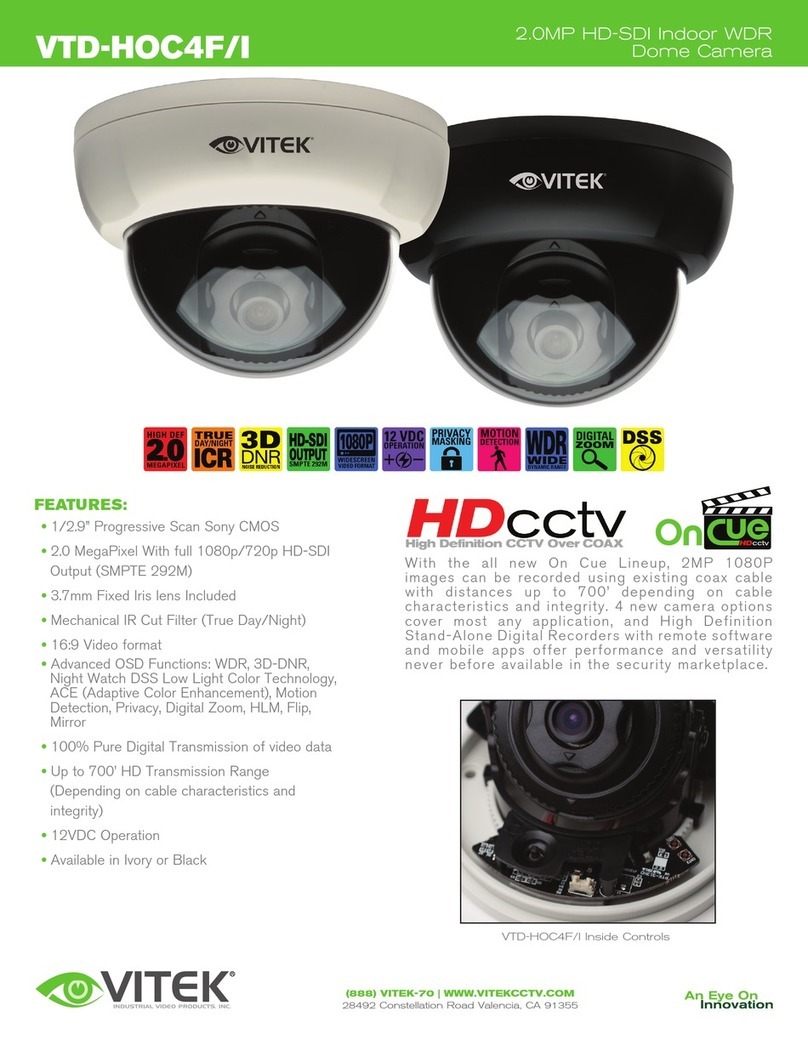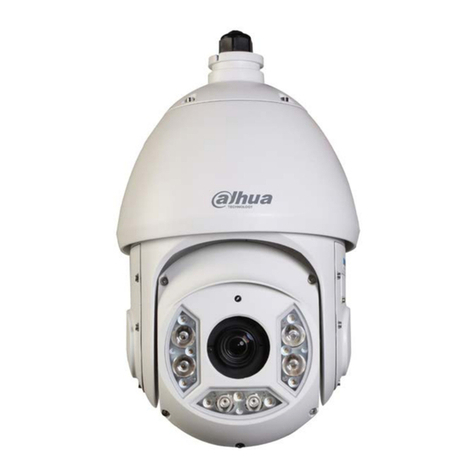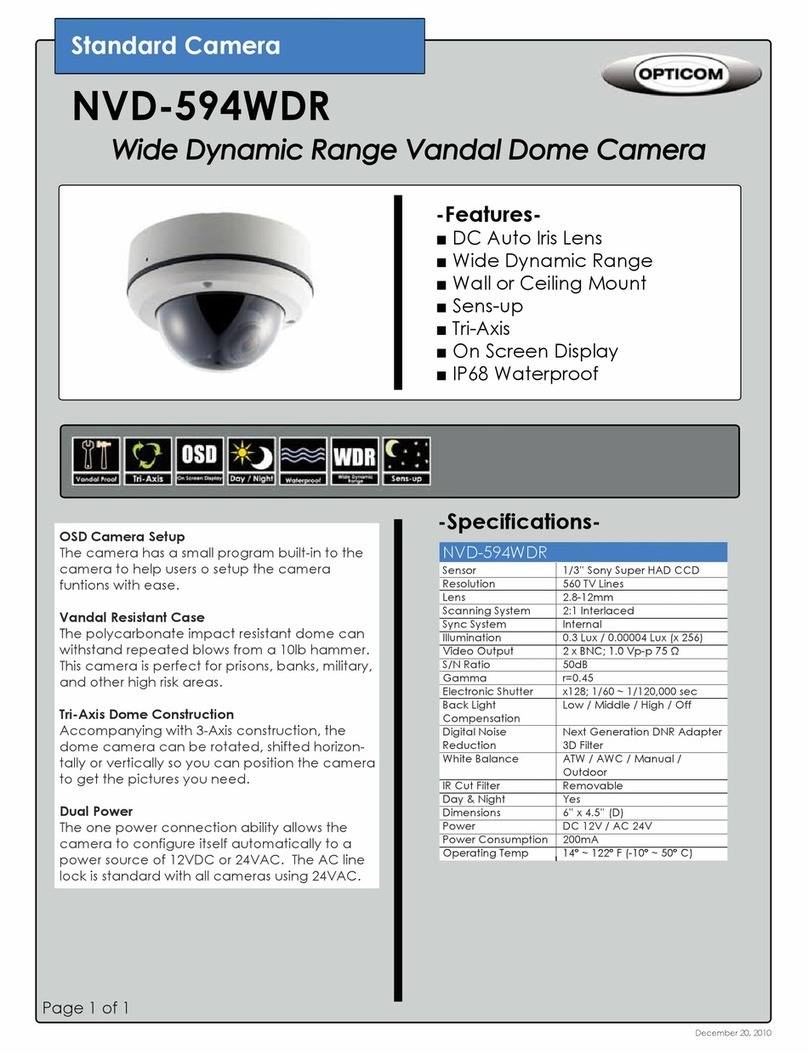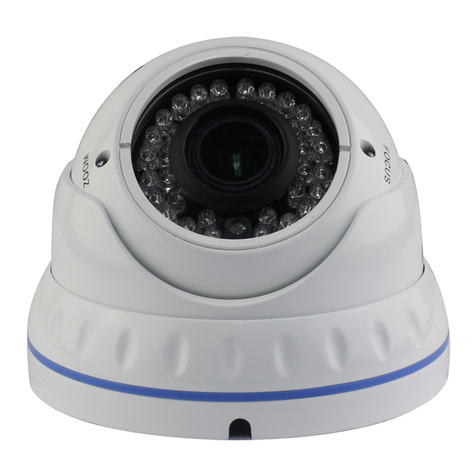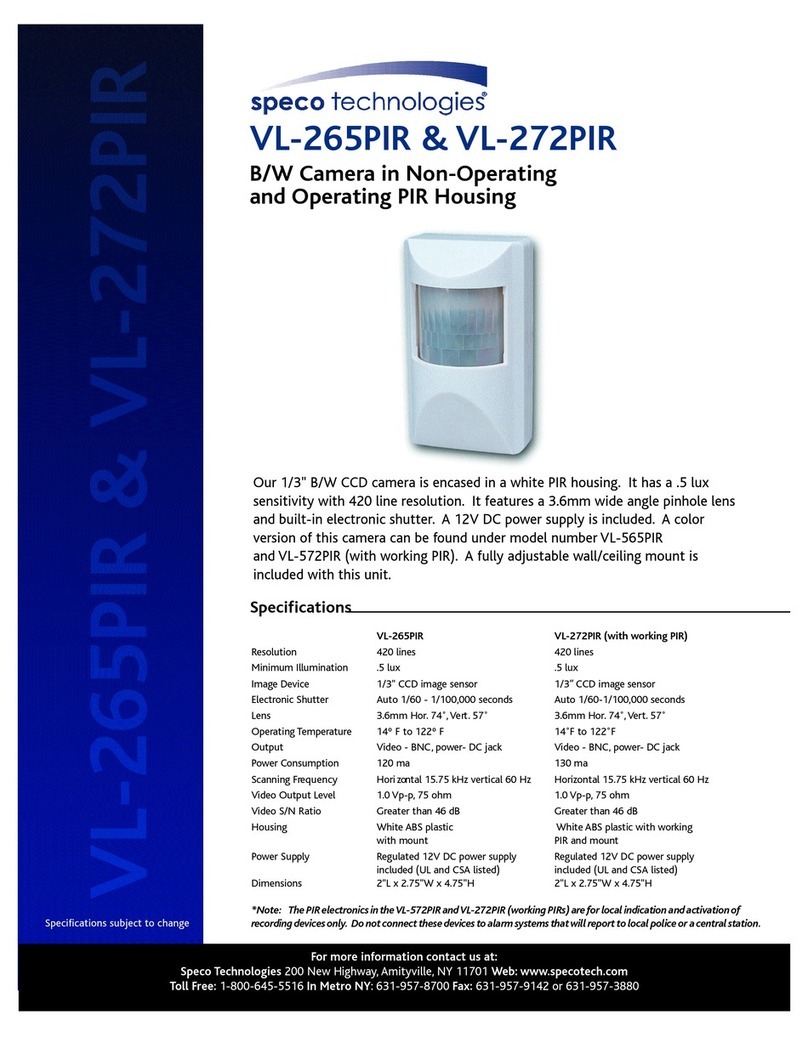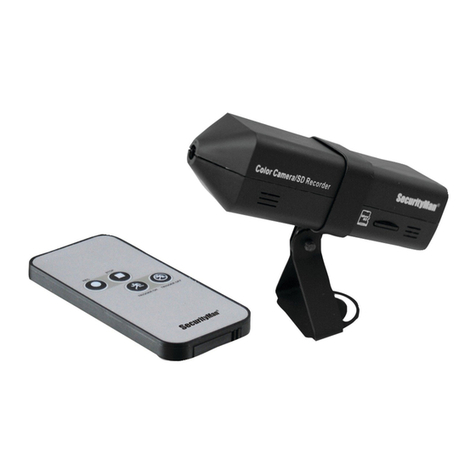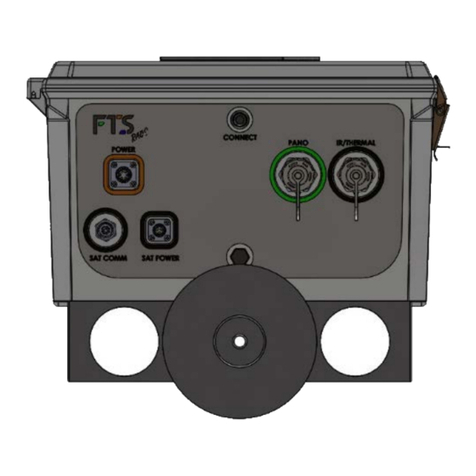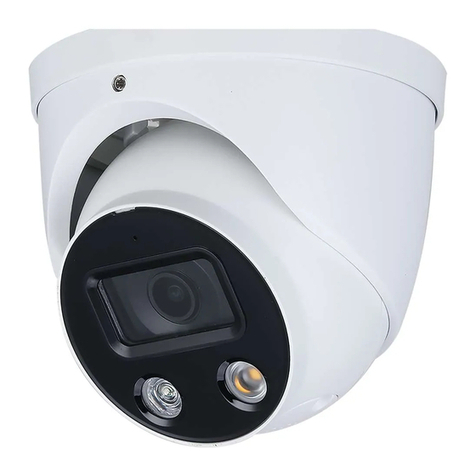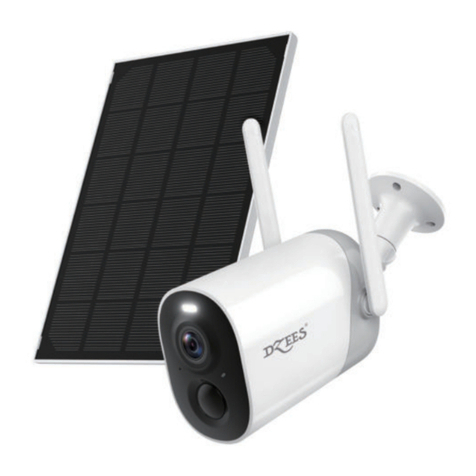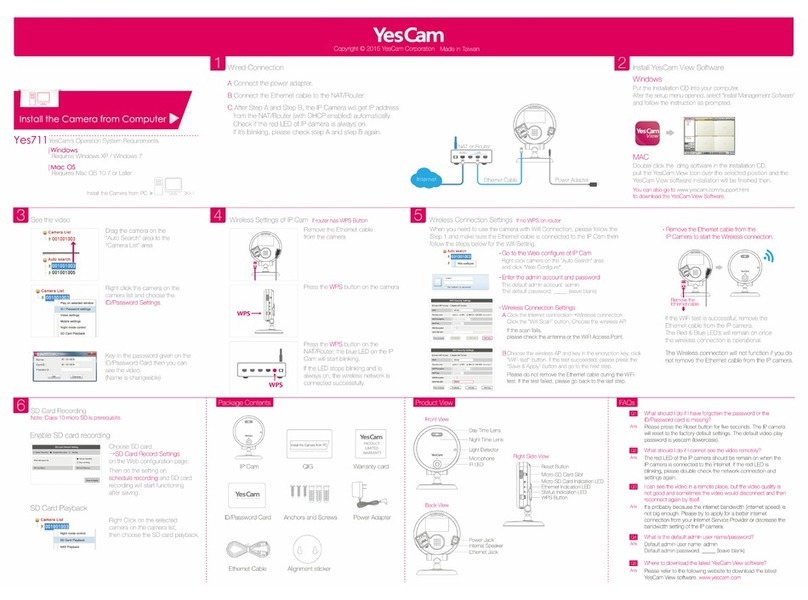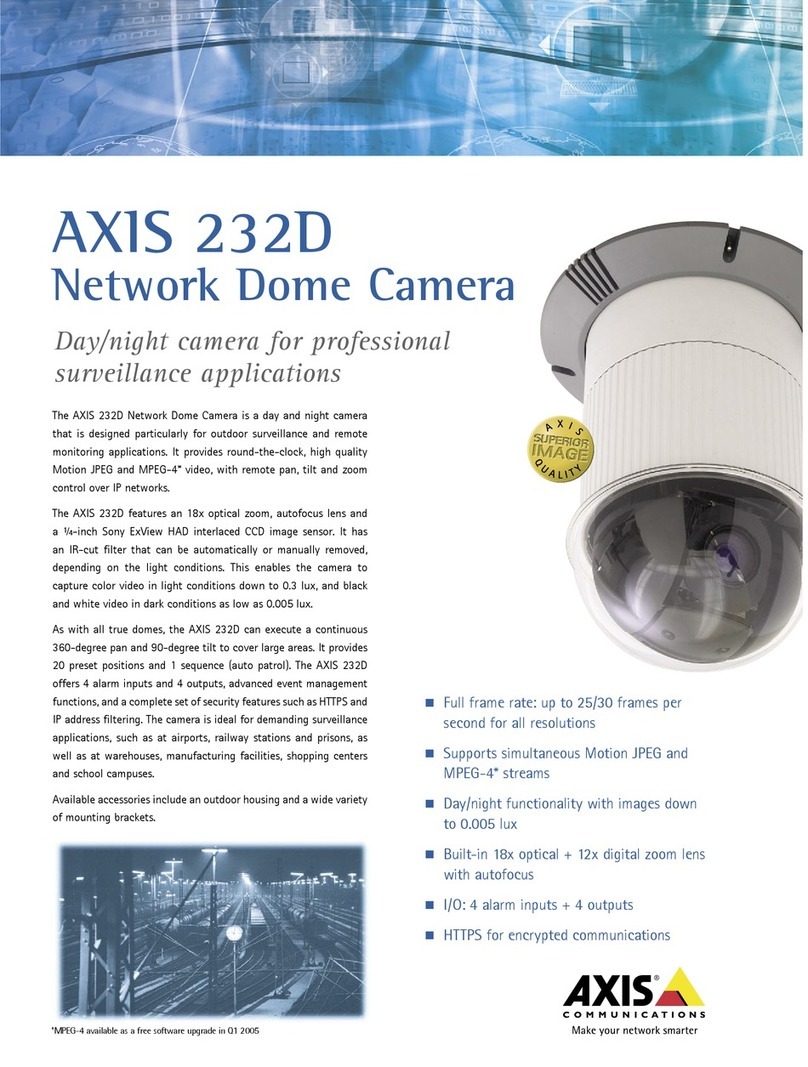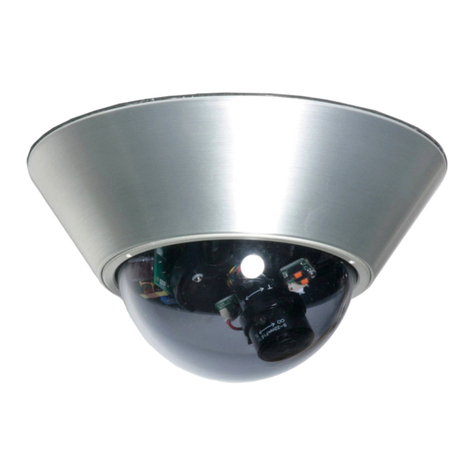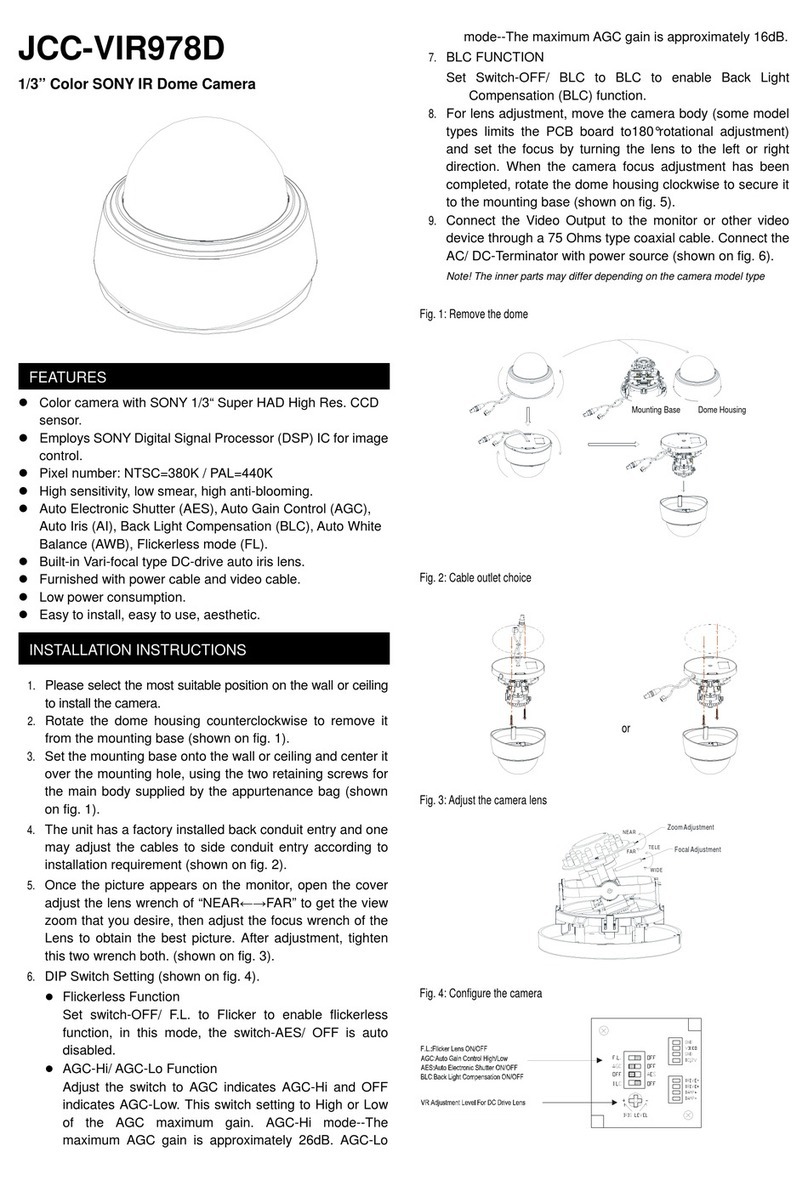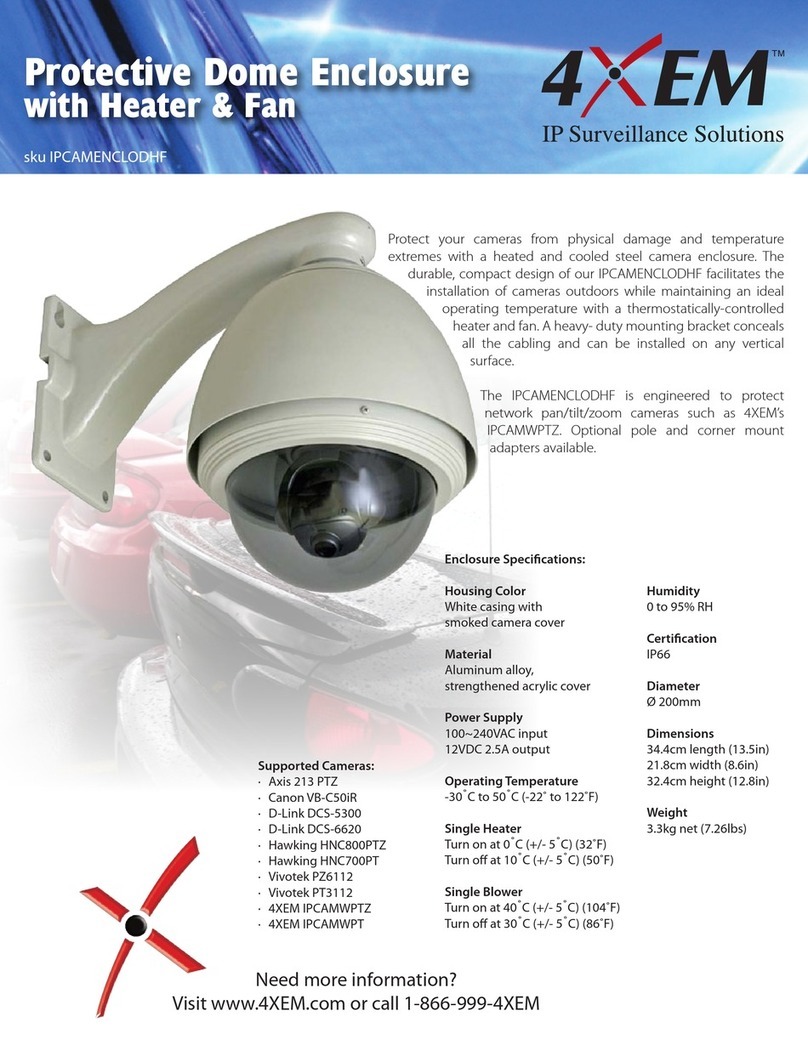Tokyo Electronic CS3910H User manual

High-resolution CCD Camera
Model CS3910H
Operation Manual
TOKYO ELECTRONIC INDUSTRY CO., LTD.
2000-09-21
Version 1.2

BEFORE USE - GENERAL SAFETY INSTRUCTIONS
This instruction manual contains important information for the operator(user) and/or people
around him/her to avoid personal injuries, or property damages against him/her or people
around him/her by using this product correctly. Prior to use, read this operation manual
carefully to fully understand its instructions for correct use.
OWNER'S RECORD
Enter the blank below Product Serial Number, which is found on bottom/rear chassis of your
device. Keep this number for your record.
Serial No.
WARNINGS & CAUTIONS
[Definition of markings]
The meaning of each mark used in this instruction manual is given below.
1
DANGER
This mark warns the user that improper use, indicated with this mark,
may cause death or severe personal injuries against the user or people
around him/her.
CAUTION
This mark warns the user that improper use, indicated with this mark.
may cause personal injuries (* 1) or material damages (*2) against the
user or people around him/her.
Notes:
*1: Personal injuries mean wounds, burns, electric shocks, and others for which the
person injured need not to be hospitalized nor to be cared for the long term.
*2: Material damages mean any direct or consequential damages related to property or
material loss.
;This mark indicates what the user SHOULD NOT DO. The details of things which the
user should not do are described next to this mark.
QThis mark indicates what the user MUST DO. The details of things which the user must
do are described next to this mark.
This mark indicates that the user must be alert against a possible DANGER. The details
of the danger which the user must be aware of are described next to this mark.
UThis mark indicates that the user are given a CAUTION against possible hazards. The
details of the caution which the user must be aware of are described next to this mark.

2
QHandling Precautions
DANGER
Unplug
If any overheating sign is observed discontinue the use immediately.
In the event that smoke, smell, or any other overheating sign is observed, turn its
power switch OFF immediately, and remove your plug from outlet. Do NOT try
to continue to use this device. To do so in spite of clear signs of malfunction
invites a fire, an electric shock hazard, or a serious damage. In such case, contact
us or our dealer /distributor from which you purchased this device for repair
service.
Unplug
If any malfunctioning sign is observed discontinue the use immediately.
Do NOT try to use this device when it is obviously malfunctioning. (Example:
No images on the monitor) In the event of malfunction, turn its power switch
OFF immediately, and remove the plug from the outlet. In such case, contact us
or our dealer/distributor from which you purchased this device for repair service.
Unplug
If any liquid gets into the device discontinue the use immediately.
In the event that water, or any other type of liquid gets into the body, do NOT try
to continue to use the device. To do so invites a fire or an electric shock hazard. In
that case, turn its power switch OFF immediately, and then remove the plug from
the outlet. After that, contact us or our dealer/distributor from which you
purchased this device for repair service/technical advice.
Unplug
If any foreign object gets into the body, discontinue the use immediately.
In the event that grits, small particles, or any other foreign objects get inside, do
NOT try to continue to use the device. To do so invites a fire or an electric shock
hazard. In that case, turn its power switch OFF immediately, and then remove the
plug from the outlet. After that, contact us or our dealer/distributor from which
you purchased this device. for repair service/technical advice.
Unplug
If any outer strong impact is given to this device discontinue the use immediately.
In the event that this device is dropped onto the ground, or its cabinet is damaged,
turn its power switch OFF immediately, and remove the plug from the outlet. Do
NOT try to continue to use the device. To do so invites a fire or an electric shock
hazard. In such case, contact us or our dealer/distributor from which you
purchased this device for repair service.
NEVER
pull apart
Do NOT disassemble this device.
Do NOT attempt to pull apart, repair, or modify the device on your own. To do so
might lead to a fire or an electric shock accident. Contact us or the
dealer/distributor from which you purchased the device for repair/modification.
;
Avoid
Do NOT supply any power other than specified.
This device is designed to work only under specified voltage. Do NOT attempt to
supply the device with power other than specified. Supplying the device with
unspecified power invites a fire or an electric shock hazard.
;
Avoid
Do NOT place the device unstably.
Do NOT place the device on an unstable table, sloped ground, etc. Make sure
that the device do not fall nor roll over to prevent an accident.

QHandling Precautions
QHandling Precautions
3
CAUTION
;
Avoid
Do NOT connect/disconnect connectors with power ON.
Before connecting/disconnecting connectors, make sure to check if the system is
powered OFF. Doing so with power ON may cause a damage or an electric shock
accident.
;
Avoid
Do NOT give a strong shock/impact against the camera-head.
Avoid giving a strong shock against the camera head. The camera-head might be
damaged.
;
Avoid
Do NOT pull/swing the cable forcefully
Do not pull strongly the camera cable/camera-head nor swing it. The stress from
pulling or swinging may cause damage in the coating of the cable, or breaks in
the inside wires.
DANGER
;
Avoid
Do NOT place any potentially-hazardous stuff on this device.
Do NOT place any object on the device which may, if it gets into the inside of the
body, damage the inner parts of the device (such as a flower pot, glass, cosmetics,
a container filled with liquids or chemicals, as well as small metal parts, etc.). If
tumbled, the liquids inside the bottle, etc. may get into the chassis, causing a fire
or an electric shock accident.
;
Avoid
Do NOT short-circuit signal outputs.
Avoid short-circuit of signal outputs. Otherwise it may cause damage to the
camera. For inspection of inner parts/circuits, adjustment, maintenance, contact
us or the dealer/distributor from which you purchased the camera.
;
Avoid
Do NOT use the camera in a high-humidity environment.
Do NOT place the camera near a humidifier, or in other high-humidity
environment.
To do so may cause a fire or an electric shock accident.
;
Avoid
Do NOT expose the camera to direct sunlight, nor intensive heat.
Do not place the camera where it is exposed to direct sunlight, or in a higher
temperature than guaranteed (Over 40 degrees Celsius). To do so may cause the
inner temperature of the camera to go up, resulting in burning-down of inner
arts, circuits or a fire accident.
;
Avoid
Do NOT expose the camera to greasy fumes.
Do NOT place the camera at the location where it is exposed to greasy fumes or
steams, or heavy dusts. To do so may cause the inner temperature of the camera to
go up, resulting in burning-down of inner parts/circuits or a fire accident.

Caution
In carrying the camera around, be sure to disconnect connection cables/lines
beforehand. Otherwise, the connection cable(s)/line(s) might be damaged, causing
a fire or an electric shock accident.
Caution
If the camera is operated in the electromagnetic field, there may be cases where beat
noises (vertical, horizontal, or oblique stripes) may appear in the video output. In
that case, take preventive measures on the electromagnetic-wave generating source
so that the camera do not receive the interference by the electromagnetic-wave.
Take extra precautions against electromagnetic-wave-interference if the camera is
used with a servomotor, inverter, or other electromagnetic-wave-generating
equipment.
Caution
When the camera is not in use, put a lens or a lens-cap onto the camera head so that
the image pickup plane of CCD is protected from dust, foreign object, or other
flaw-causing object. If the glass plane (image pickup plane) gets dirty, clean it with
a cotton swab. When it needs to be cleaned with a cleaner, be sure NOT to use any
organic solvent other than ethyl alcohol. As a countermeasure against
condensation, when the camera is moved from a warm place to a cold place, take
appropriate precautions to prevent condensation from forming on the camera.
Caution
Avoid placing the camera where it is splashed with water or any other fluids.
Operating the camera with its inner parts/circuits in wet condition may cause a
damage or an electric shock accident.
RESTRICTION FOR USE
Do not attempt irregular signal interface other than specified. Under signal interface other than
recommended/specified in this instruction manual, the camera might fail to exert the
maximum performance. In much worse case, if you continue to use, the camera under incorrect
signal interface, parts) of circuits might burn down.
In case malfunction of this equipment (e.g. video output cut-off) can be expected to lead to
significant accident, avoid using this equipment for such system build-in use.
DISCLAIMER (LIMITED WARRANTY)
We disclaim any responsibility and shall be held harmless for damages or losses incurred by
user(s) in either of the following cases.
1.In case damages or losses are caused by fire, earthquake, or other acts of Gods, the act by
third party, misuse by the user deliberately or erroneously, use under extreme operating
conditions.
2.In case any indirect, additional, consequential damages (loss of expected interest,
suspension of business activities) are incurred as results of malfunction or non-function of
this device, we shall be exempted from assuming responsibility for such damages.
3.In case damages or losses are caused by incorrect use which is not in line with the
instructions given in this instruction manual.
4.In case damages or losses are caused by malfunction resulting from bad connection with
other equipment.
5.In case damages or losses are caused by repair or modification done by the user.
4

CONTENTS
1. PRODUCT DESCRIPTION -------------------------------------------------- 5
2. FEATURES ----------------------------------------------------------------------- 5
3. COMPONENTS ----------------------------------------------------------------- 6
4. OPTION UNITS ---------------------------------------------------------------- 6
5. REAR PANEL CONNECTORS --------------------------------------------- 7
6. HOW TO MOUNT YOUR CAMERA ------------------------------------- 7
7. INTERFACE --------------------------------------------------------------------- 8
8. SWITCH / MODE SETTINGS ---------------------------------------------- 9
9. SPECIFICATIONS ------------------------------------------------------------- 15
10. TIMING CHART --------------------------------------------------------------- 17
11. EXTERNAL-VIEW DRAWINGS ------------------------------------------ 21
1. PRODUCT DESCRIPTION
Model CS3910H is an integrated-(one-body)-type monochrome CCD camera with a 2/3-type
all-pixel-data-read-out CCD featuring ultra-high resolution.
2. FEATURES
(1) Ultra-high Resolution
CS3910H features an ultra-high picture resolution through the adoption of a MEGA-pixel CCD
(Total pixel counts: 1,400,000 Active pixel counts: 1,300,000 [1,300(H)X 1,030(V)]).
(2) Square-grid Pattern CCD
Pixels in this CCD are aligned in a square grid pattern. This makes it easier to perform computation
correctly for image processing use.
(3) Full-frame Shutter
As data in all pixels are read out even under RTS mode, images with no deterioration in vertical
resolution are obtained.
5

6
(4) Random Trigger Shutter (RTS)
Random trigger shutter, which starts light-exposure in synchronization with external trigger
signal,
is built in. This function enables the camera to capture images at any given timing. Shutter speed
is selectable among 8 scales, from 1/30s through 1/10000s.
(5) Digital Output
In addition to conventional analog output, digital format output (EIA-644 single channel 10 bit)
is
also available.
(6) External-sync Operation
Upon receiving external HD/VD IN, the camera automatically switches into ex-sync operation.
(7) Double-speed Scan Mode
The double-speed scanning (24 frame/second) is available by using mixed reading-out scanning
method to read each vertical 2 pixel out at the same timing.
(8) Partial-scan Mode
This model can readout pixel data in partial-scan format. (Screen center 1/2)
(9) AGC
With AGC (Automatic Gain Control) function, the camera can obtain the optimal image even if
the amount of incoming light fluctuates.
(10)Multiple Shutter
This model can capture images at any given timing cued by ex-trigger signal input, then outputs
accumulated video images at a set timing.
3. COMPONENTS
(1)Camera body -----------------------1
(2)Accessories
Operation manual -----------------------1
4. OPTION UNITS
(1)Cable A (DC IN cable) -----------------------1
(2)Cable B (Digital video cable) -----------------------1
(3)Camera mounting hardware -----------------------1

5. REAR PANEL CONNECTORS
1. DC IN/SYNC: DC+12V Power IN Analog Video OUT, and TRIG/WEN Terminal
This connector is for connection with a power supply, image processing equipment
2. DATA OUT Connector: Digital Data Output Terminal
This terminal is for outputting video signal and HD, VD, and CLK in RS-644 format.
For connection with an image processing equipment.
6. HOW TO MOUNT YOUR CAMERA
(1)Option 1: Camera tripod fixing kit
Use a dedicated tripod fixing kit (option unit) to fix your camera onto a tripod, etc.
(See the diagrammatic sketch shown below)
7

(2)Option 2 : Mounting holes (Bottom side)
Put M3 screws through screw-holes to fix the camera. Be sure to use screws which are shorter than
specified length. Longer screws may damage the inner circuit board.
(2-1)To fix your camera by using the mounting holes (a) above (= 2 places), be sure to use 3mm or
shorter screws.
(2-2)To fix your camera by using the mounting holes (b) above (= 4 places), be sure to use 5mm or
shorter screws.
(2-3)To fix your camera by using the mounting holes (c) above (= 2 places), be sure to use 3mm or
shorter screws.
7. INTERFACE
(1) DC IN/SYNC
Connector (Camera side): HR10A-10R-12PB (Manufactured by HIROSE DENKI)
Plug (Cable side): HR10A-10P-12S (Manufactured by HIROSE DENKI)
(2) DATA OUT
Connector (Camera side): DX10A-36S
Connector (Cable side): DX30A-36P, DX-36-CV 1 (Cover)
DATA0: LSB, DATA9: MSB
8
Pin number Signa1 name
1 GND
2 +12V
3 VIDEO GND,
4 VIDEO OUT
5 HD GND
6 E.HD IN
7 E. VD IN
8 GND
9 N.C.
10 WEN
11 TRIG
12 VD GND
Rear
-
view
Pin. Signal name Pin. Signal name Pin. Signal name Pin. Signal name
1 DATA0-H 10 DATA4-L 19 DATA9-H 28 E.HD IN
2 DATA0-L 11 DATA5-H 20 DATA9-L 29 E.VD IN
3 DATA1-H 12 DATA5-L 21 VD OUT-H 30 N.C.
4 DATA1-L 13 DATA6-H 22 VD OUT-L 31 BUSY
5 DATA2-H 14 DATA6-L 23 HD OUT-H 32 WEN
6 DATA2-L 15 DATA7-H 24 HD OUT-L 33 N.C.
7 DATA3-H 16 DATA7-L 25 CLK-H 34 N.C.
8 DATA3-L 17 DATA8-H 26 CLK-L 35 GND
9 DATA4-H 18 DATA8-L 27 TRIG IN 36 GND

8. SWITCH / MODE SETTINGS
The settings of each mode can be done with rear-panel and inner DIP switches. To select modes,
slide DIP switches numbered 1 through 6. The status is OFF when SW is in left position, ON when
in ri
g
ht
p
osition.
Rear DIP SW Setting Enabled Function
Mode SW1-3 SW1-4 SW1-2 Partial-scan SW1-
5)
Double-speed-
scan *2
AGC (SW1-1)
OFF
-Shutter
OFF
OFF
OFF ON
OFF
OFF
ON ON
Normal
Shutter
* 1
OFF
XXXX
(OFF)
ON
ON XXXX (OFF) XXXX (OFF)
RTS
Pulse
Mode
OFF
RTS
Fix
Mode * 1
OFF
ON
Notes:
1. Normal E shutter doesn't work under partial
scan mode.
2. Under RTS (Random Trigger Shutter) and
multiple-shutter mode, double-speed scan
function doesn't work.
Multiple
Shutter
Pulse
Mode
OFF
Multiple
Shutter
Fix
Mode *
ON
ON
ON
* 1: The shutter-speed selectable with inner DIP switches 2 through 4.
*2: ON / OFF selectable with inner DIP SW 1.
(Left: OFF - Right: ON)
AGC ON/OFF Selection
Shutter Mode Selection
Partial-scan ON/OFF
Not assigned (OFF fixed)
SW1 Rear SW
(Factory setting)
9

Readout Mode Selection
Shutter Speed Selection
Not assigned (OFF fixed)
Not assigned (OFF fixed)
SW2 Inner SW
(Factory setting)
(1)Readout Mode Setting (SW2 DIP 1) (Initial-Factory-Setting: OFF)
OFF: 12Hz All Pixel Data Readout Mode (Normal mode)
ON: 24Hz Double-Speed Scan Mode (As vertical 2 pixels are read out at the same timing under
this mode, vertical resolution is reduced to 1/2)
Note: Under the random-trigger-shutter, multiple-shutter, and partial-scan mode, the double-speed
scan function doesn't work.
(2)Shutter Speed (SW2 DIP2, 3&4) (Initial-Factory-Setting: DIP2-2, 2-3, 2-4 OFF)
(3)RTS (Random Trigger Shutter) Pulse Control
The camera goes into RTS (Random Trigger Shutter) mode when TRIG terminal voltage is in
HIGH (More than 1V), and starts light-exposure at the falling edge timing. Under FIX mode,
the exposure-time is controlled with inner DIP switch settings. The exposure starts at the next
HD timing immediately after TRIG IN.
Under PULSE mode, the exposure-time is determined by pulse length. The exposure starts at
the next HD timing immediately after TRIG IN. The exposure-time control is done in 1H steps.
Be sure to set the pulse length longer than 1 H (=Approximately 80 micro s) After video-output,
it goes back into normal operation (=Shutter OFF) if the TRIG terminal voltage stays in LOW
10
SW2-2 SW2-3 SW2-4 Shutter Speed
OFF OFF OFF 1/30s (Initial)
ON OFF OFF 1/60s
OFF ON OFF 1/125s
ON ON OFF 1/250s
OFF OFF ON 1/1000s
ON OFF ON 1/2000s
OFF ON ON 1/4000s
ON ON ON 1/10000s

for consecutive 2V or longer, regardless of which RTS mode is currently set in. The HD ex-sync
operation is available, while the VD ex-sync is not. The double-speed scan doesn't work.
Video Output Timing
-1. Under FIX mode
*The VD is output in sync with the next HD after light-exposure.
-2. Under PULSE mode
*The VD is output in sync with the next HD after light-exposure
11
TRIG
CCD
(Exposure)
VIDEO
OUT
HD
VD
WEN
TRIG
CCD
(Exposure)
VIDEO
OUT
HD
VD
WEN

Exposure-time T = T2 + Ty + Tx
Ty: Max. 1 H (Approx. 80 micro s)
Tx: Fixed Delay (Approx. 33.8 micro s)
(4)Multiple-shutter Mode Setting (SW1 DIP4)
The multiple-shutter ON/OFF selection is made with the rear SW1 DIP4 under RTS mode. (Initial
factory setting: OFF) Exposure is done during the one frame period which comes immediately after
TRIG IN. Images are output at the readout signal (E.VD) timing. If the exposure is made more
than
one time before the readout signal input, superposed images are output. After video-output, it goes
back into the normal operation (= shutter OFF) if the TRIG terminal voltage stays in LOW for 2V
or longer consecutively, regardless of which RTS mode is currently set in. The ex-sync operation is
OK with HD IN. The double-speed scan doesn't work. Please be noted that S/N decreases under
this mode if and when too much time is taken from the light-exposure through readout.
-1. Under FIX mode
12
TRIG IN
HD
Exposure
Exposure TRIG
Readout E.VD
CCD(Exposure)
VIDEO OUT
HD
SUB
SG
Phi VINH
WEN

-
2. Under PULSE mode
-
3. Multi
p
le Camera O
p
eration
By using the multiple-shutter, multiple images which are captured by more than one camera (=simultaneous exposure)
are readout individually. This allows multiple image-processing on a serial basis, requiring only one image-processor.
13
Exposure TRIG
Readout E.VD
CCD(exposure)
VIDEO OUT
HD
SUB
SG
Phi VINH
WEN
TRIG
CAMERA 1
E. YD
CAMERA 2
E. VD
CAMERA 3
E. VD
CAMERA 1
CCD(Exposure)
CAMERA 2
CCD (Exposure)
CAMERA 3
CCD (Exposure)
CAMERA 1
VIDEO OUT
CAMERA 2
VIDEO OUT
CAMERA 3
VIDEO OUT

(5) Partial-scan Mode Setting (SW1 DIP5)
The partial-scan ON/OFF selection is made via the rear SW1 DIP5 (Initial factory setting: OFF)
When set ON, the 1/2 screen center is readout.
OFF: Normal mode
ON: 1 /2 --- Screen-center 1/2 readout
The HD ex-sync operation is OK, while the VD ex-sync operation is not. The double-speed scan
doesn't work.
*Screen Center 1/2 Readout
Total Lines 1034 Lines
Scanning Area 474 Lines
14
High-speed Transfer
Open Area 280 Lines
Normal-speed Transfer
Open Area 474 Lines
High-speed Transfer
Open Area 280 Lines
High-speed Tfr. 20 Lines
Normal-speed Tfr. 474 Lines
High-speed Tfr. 20 Lines
Total Lines = Open 514
Lines + Optical Black 6
Lines = Approx. 24.1 Hz
Video Output
(Normal)
Video Output
(Center 1/2)

9. SPECIFICATIONS
Model CS3910H
TV system Non-Standard
Image sensor Interline CCD
Total pixel 1360(H) x 1034(V)
Active pixel 1300(H) x 1030(V)
Unit cell size 6.7(H) x 6.7(V) micrometer m
Optical size Equivalent to 2/3 inch image pickup tube
Scanning system Non-interlace
Scanning frequency 12.528kHz(H)
12Hz(V) (All pixel data read-out mode) or
24Hz(V) (Vertical 2 pixels read-out mode)
Aspect ratio 5:4
Sync system Internal / External automatic switchover
Illumination 400 lx (F8 3200K)
S/N 50dB(p-p/rms) (Under normal mode)
Video output Digital output: EIA-644
Data: 10bit (20.2MHz)
Analog output: 1.0V(p-p)/75-ohm (Unbalanced)
AGC Video signal output. fluctuation of plus/minus 2dB or less against
standard subject illumination minus 6dB
(Enabled under normal mode only)
External input signal
Trigger signal
TTL level, Negative
Input impedance: 10k-ohm
Pulse width: Longer than 80 micro s
Multiple-shutter readout signal
TTL level, Negative
Input impedance: l0k-ohm
Pulse width: From 80 micro s through 10ms
External sync signal HD
TTL level, Negative, Input impedance: l0k-ohm
Repeating frequency 12.528kHz plus/minus 1 percent
Pulse width: Longer than 10 micro s
VD
TTL level, Negative, Input impedance: 10k-ohm
Repeating frequency 12Hz plus/minus 1 percent
Pulse width: From 700 micro s through 10ms
Output signal WEN
4V (p-p), Positive, Pulse width: 1H (Approx. 80 micro s)
15

16
HD [Output from DC IN / SYNC]
4V(p-p), Negative (Output via inner SW switching)
Repeating frequency 12.528kHz plus/minus 100ppm
[Output from DATA OUT]
EIA RS644 (LVDS)
Driver output voltage: Plus/minus 350mV
(Differential output) / 100-ohm
VD
[Output from DC IN / SYNC]
4V(p-p), Negative (Output via inner SW switching)
Repeating frequency 12Hz plus/minus 100ppm
[Output from DATA OUT]
EIA RS644 (LVDS)
Driver output voltage: Plus/minus 350mV
(Differential output) / 100-ohm
Gamma correction OFF (Gamma = 1.0)
Shutter speed 8 scales from 1/30s through 1/10000s
RTS Random Trigger Shutter
ON/OFF selectable (Initial factory setting: OFF)
Fix mode --- Exposure-time determined by E shutter-speed
Pulse mode --- Exposure-time determined by pulse length
Partial scan ON/OFF selectable (Initial factory setting: OFF)
ON --- Screen center 1/2 readout
Multiple shutter ON/OFF selectable (Initial factory setting: OFF)
Fix mode --- Exposure-time determined by E shutter-speed
Pulse mode --- Exposure-time determined by pulse length
Lens mount C mount
Power source DC 12V plus/minus 10 percent
Power consumption Approximately 3.6W
Ambient condition
Performance guaranteed
Temperature : From 0 through 40 degree Celsius
Humidity : From 10 through 90 percent (No condensing)
Operation guaranteed
Temperature : From -5 through 45 degree Celsius
Humidity : Less than 90 percent (No condensing)
Spectrum response characteristics (Typical)
Refer to table SRC below. Graph reflects lens characteristics, but do
not reflect that of light-source.
External dimension 49(W) x 35(H) x 98(D)mm
Weight Approx. 170g

Table: Typical SRC
X-axis: Wave-length
Y-axis: Relative response
10. TIMING CHART
10-1. Analog output
(
1
)
H rate
1 CLK = 49.4ns (20.245MHz)
H-SYNC A = 2.47 micro s
HBL B = 15.61 micro s
Front porch C = 4.94 micro s
Back porch D = 8.20 micro s
DATA E = 64.21 micro s
H rate F = 79.82 micro s
17

(2) V rate
All data read-out mode Double-scan mode
A = 3H A = 2H
B = 14H B = 7H
C = 9H C = 4H
D = 2H D = 1H
E = 1030H E = 515H
F = 1044H = 12Hz F = 522H = 24Hz
ENLARGED VIEW. V RATE A
1. Under normal mode
VD
VIDEO
H rate a = 79.82 micro s
V.SYNC b = 4.94 micro s
2. Under RTS mode
VD
WEN
VIDEO
*c: Approximately 1H
18

10-2. Digital output
EIA RS644 standard (LVDS)
Driver output voltage Plus/minus 350mV (Differential output) / 100-ohm
HD
DATA
CLK
Total clock counts: 1616CLK / 1H
DATA counts: 1300CLK / 1H
CLK 49.4ns
V rate phase: Same as one in analog timing-chart
HD, VD output phase lag
--- No phase lag
HD
VD
19
Table of contents
Other Tokyo Electronic Security Camera manuals
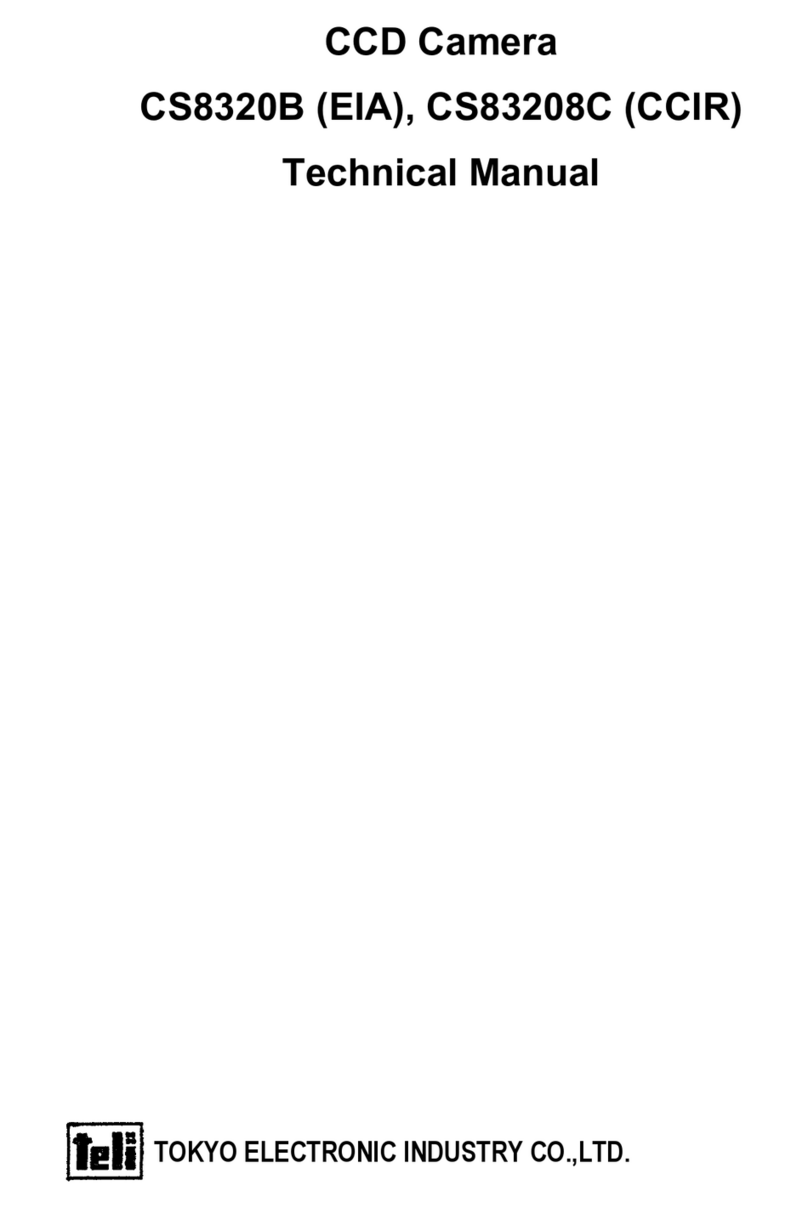
Tokyo Electronic
Tokyo Electronic CS8320B User manual

Tokyo Electronic
Tokyo Electronic CS9200 User manual

Tokyo Electronic
Tokyo Electronic CS8530-01 User manual

Tokyo Electronic
Tokyo Electronic CS8550i-01 User manual
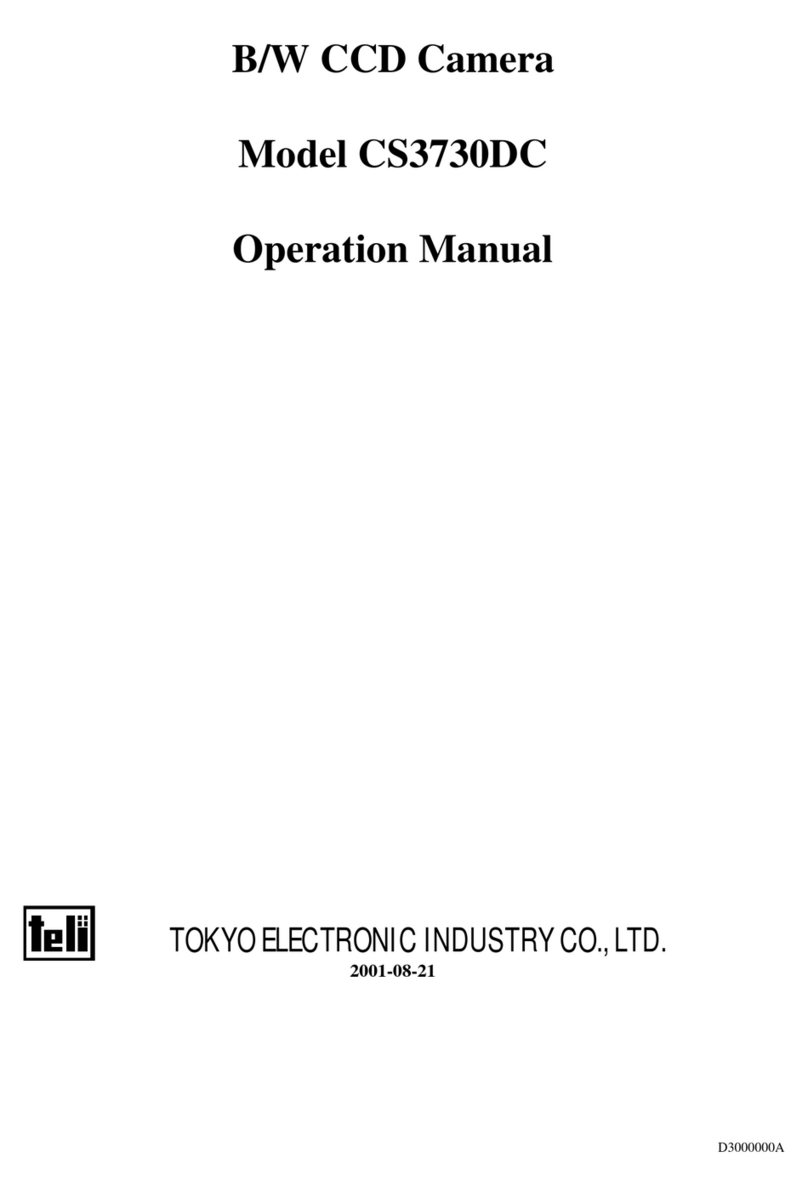
Tokyo Electronic
Tokyo Electronic CS3730DC User manual
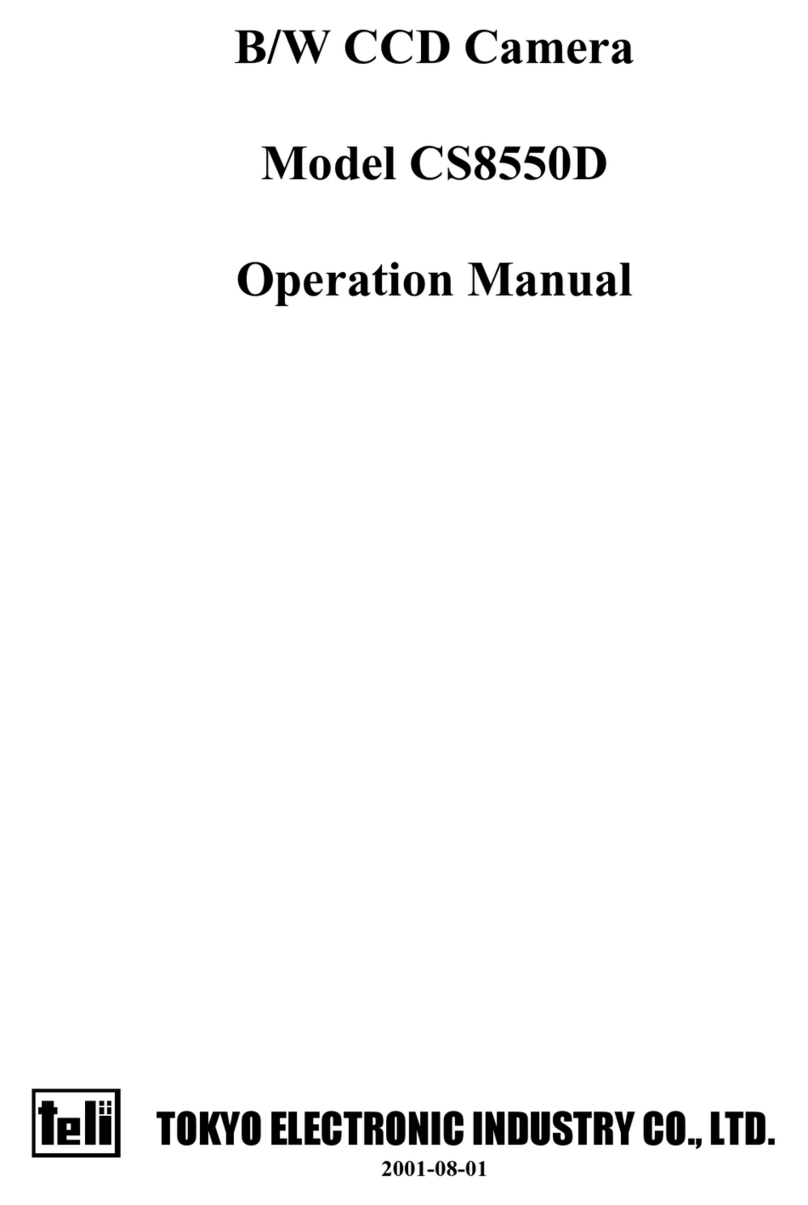
Tokyo Electronic
Tokyo Electronic CS8550D User manual

Tokyo Electronic
Tokyo Electronic CS8320B User manual
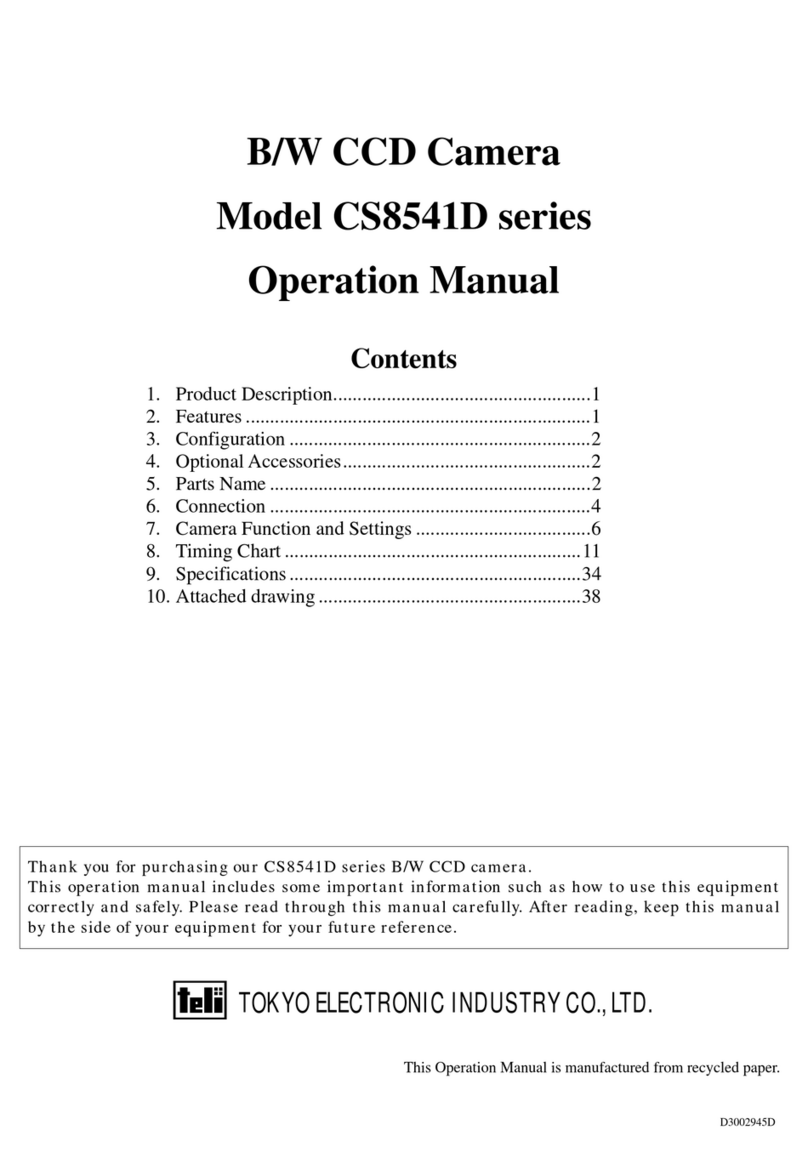
Tokyo Electronic
Tokyo Electronic CS8541D series User manual

